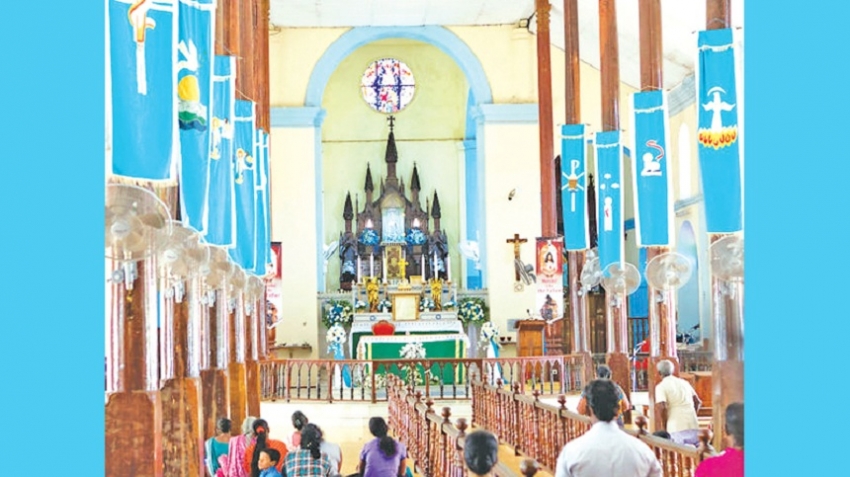• President Maithripala Sirisena signs declaration
• 3,000 acres for buildings and religious activities and 5,000 acres of protected areas
The scroll or the traditional Sannas Pathraya (scroll) declaring the Shrine of Our Lady of Madhu as a Sacred Site was presented by President Maithripala Sirisena to the Bishop of the Diocese of Mannar Most Reverend Dr Emmanuel Fernando at the President’s Office on Tuesday (October 29).
Our Lady of Madhu, Sri Lanka’s holiest Catholic shrine, is venerated by Sinhala Buddhists and Hindu Tamil communities too. The site attracts thousands of local and international visitors, especially during the annual feast. The surrounding areas had not been developed due to the prolonged armed conflict and negligence.
President Sirisena said that it was a pleasure to be able to take measures during his tenure to protect this sacred and historically significant site venerated by all the communities.
During a visit to the site in July 2018, the attention of the President was drawn to the dilapidated status of the site and the Cabinet of Ministers approved the proposal made by the President to protect this historical religious site and to develop facilities provided to the visitors.
Religious activities
Accordingly, projects including upgrading transport and road facilities, drainage systems and sanitation facilities and accommodation facilities are currently underway.
As per the Gazette notification declaring the historical Madhu Shrine as a Sacred Site, approximately 3,000 acres from the area has been allocated to construct buildings to facilitate religious activities of the Shrine and 5,000 acres have designated as protected areas.
Madhu Church is situated in Mannar, which is also considered one of the oldest seaports in the island. In past eras, it was known as Mahathittha. The Portuguese too built a fort in Mannar and subsequently the Dutch captured the area.
The story of Our Lady of Madhu begins in the second half of the 17th century when the statue of Our Lady of Good Counsel, was moved from Mantai in Jaffna peninsula to Madhu, in Mannar. This was during the Dutch period when the colonial rulers took harsh views on the Catholics and either destroyed or forced closure of Catholic churches and proscribed Catholic priests from functioning. The conquest of the island by the Dutch opened an era of cruel persecution against the Catholics and the faithful of Mantai were forced to consider seriously the desirability of removing the statue of Our Lady of Mantai to a haven of safety.
Since installation in Madhu in 1670, the statue rapidly developed a reputation for miracles – it was particularly revered as offering protection from snake bites – and Madhu has been a place of pilgrimage ever since. The present church dates from 1872 and is quite austere but has soaring central columns. Outside, the most striking feature is the elongated portico painted cream and duck-egg blue. The church attracts huge crowds of pilgrims to its 10 annual festivals, especially the one on August 15. The grounds now boast huge golden statues representing the stations of the cross.
Revered Oratorian priest from Goa, Saint Joseph Vaz also came to the area during this period and took refuge at Madhu.
The shrine of Madhu received papal recognition when Pius XI permitted a solemn canonical “coronation” of Our Lady of Madhu, which was accomplished in 1924, with the church being formally consecrated in 1944.
During the 30-year long ethnic conflict Our Lady of Madhu was brought out three times for a “penitential pilgrimage” throughout Sri Lanka to end the war.
While July 2 is the official festival day for Our Lady of Madhu, the celebration that draws most crowds is the Feast of the Assumption on August 15. On that date, Our Lady of Madhu is brought out for a formal procession.
Our Lady of Madhu
The unique feature of Madhu is, it is sacred to both Tamil and Sinhala Catholics, Buddhists and Muslims would also come to the shrine to pay respects to Mother Mary. Inside the church, pilgrims walk on their knees to approach Our Lady of Madhu and present their intentions. Flowers are also offered — which interestingly is also characteristic of worship in Buddhist and Hindu temples. Madhu Shrine hosts pilgrims throughout the year. Usually, pilgrims come for several days and stay in one of the hostels especially reserved for them.
Madhu Church has a large “Ave Maria” sign, along with its transliterations in Sinhala and Tamil. Cut into the floor of Our Lady of Madhu Church is a pit that holds soil from the area in which St. Joseph Vaz said Mass while at Madhu. The soil is reputed to have curative properties and is especially used as an antidote for snakebite. Madhu soil is mixed in concrete for the foundations of Catholic homes, and the soil is sometimes added to water and consumed by pilgrims.
Surrounding Madhu Church is a large Way of the Cross. A panoramic view of the area gives a sense of the space needed to accommodate crowds during festivals.
Pope Francis travelled to the Madhu Church during his visit in 2015, where he urged Sri Lankans as a whole to forgive one another “for all the evil which this land has known.” An estimated 300,000 people waving the white and yellow Vatican flags welcomed Pope Francis to the Our Lady of Madhu shrine. “Only when we come to understand, in the light of the cross, the evil we are capable of and have even been a part of, can we experience true remorse and true repentance,” the Pope said after setting free a dove in a sign of peace. “Only then can we receive the grace to approach one another in true contrition, offering and seeking true forgiveness.”
With the allocation of 3,000 acres of land, the Madhu Church will be able to undertake a major development plan to construct buildings for religious services and hostel facilities for pilgrims. The reservation of 5,000 acres of surrounding land extent will ensure environmental sustainability of the area.




















